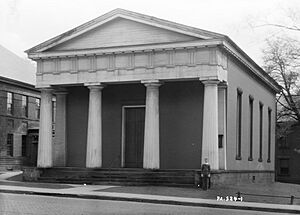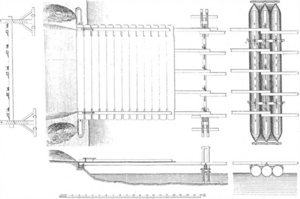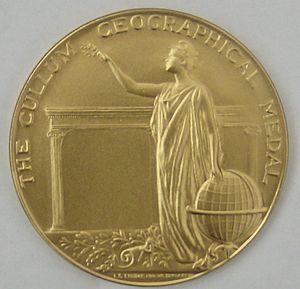George Washington Cullum facts for kids
Quick facts for kids
George Washington Cullum
|
|
|---|---|

George Washington Cullum
|
|
| Born | 25 February 1809 New York City, New York |
| Died | 28 February 1892 (aged 83) New York City, New York |
| Place of burial |
Green-Wood Cemetery, Brooklyn, New York
|
| Allegiance | United States of America Union |
| Service/ |
United States Army< Union Army |
| Years of service | 1833–1874 |
| Rank | |
| Unit | Corps of Engineers |
| Commands held | United States Military Academy |
| Battles/wars | American Civil War |
| Awards | Cullum Geographical Medal (establisher) |
| Other work | Author |
George Washington Cullum (born February 25, 1809 – died February 28, 1892) was an important American soldier, engineer, and writer. He helped build and fix many important forts across the country. Cullum was a general in the Union Army during the American Civil War, mostly fighting in the western parts of the country. He also served as the leader of the United States Military Academy (West Point).
After he retired from the Army, he became an important person in New York society. He was part of many groups, including being a vice president of the American Geographical Society. They even named a special medal, the Cullum Geographical Medal, after him!
Contents
Early Life and Education
George Washington Cullum was born in New York City on February 25, 1809. His parents were Arthur and Harriet Sturges Cullum. He grew up in Meadville, Pennsylvania. His father worked as a lawyer and helped manage land.
Cullum attended the United States Military Academy at West Point. He studied there from July 1, 1829, to July 1, 1833. He graduated as the third best student in his class. Cullum designed the Independent Congregational Church in Meadville. It was built between 1835 and 1836 and is now a historic building.
Before the Civil War
Cullum joined the United States Army Corps of Engineers as a second lieutenant on July 1, 1833. He worked as an assistant engineer at Fort Adams that same year. For the next two years, he helped the chief engineer in Washington D.C. He also inspected forts in Annapolis, Maryland, before returning to Fort Adams.
Cullum was promoted to second lieutenant on April 20, 1836. He then oversaw building projects on Goat Island until 1838. On July 7, 1838, he became a captain. Cullum then supervised the building of Fort Trumbull in New London, Connecticut. He also worked on the lower battery at Fort Griswold in nearby Groton until 1855.
From 1840 to 1864, he managed many other projects along the East Coast. These included fixing sea walls on several islands. He also helped build forts like Warren, Independence, Winthrop, and Sumter. He oversaw the building of cadet barracks at West Point. Cullum also worked on the United States Assay building. Later, he managed engineering work on rivers in the western United States.
Cullum taught military engineering at West Point from 1848 to 1851. He then became the director for military engineers and bridge builders at West Point. In 1850, he published an early version of his famous Biographical Register. He took two years off from 1850 to 1852 for health reasons. During this time, he traveled around Europe, Asia, Africa, and the West Indies. Cullum then returned to West Point and taught there until 1855. When Robert E. Lee, who was the superintendent of West Point at the time, went on vacation, Cullum was the acting superintendent from July 5 to August 27, 1853.
In 1848, Cullum created a new type of pontoon bridge. This bridge was used during the Mexican–American War. He wrote a book about it in 1849 called Description Of A System Of Military Bridges, With India-Rubber Pontons.
Civil War Service
On April 9, 1861, Cullum was promoted to lieutenant colonel, and soon after, to colonel. He worked as an aide-de-camp (a personal assistant) for General Winfield Scott from April 1 to November 1, 1861. At the same time, he was part of the United States Sanitary Commission, which helped soldiers.
Cullum became a major in the Corps of Engineers. Then, on November 19, 1861, he became the chief engineer for the Department of the Missouri. He stayed there until March 11, 1862. After that, he was the chief engineer for the Department of the Mississippi until July 11.

During this time, he was also the chief of staff for General Henry Halleck. Cullum was made a brigadier general of volunteers on November 1, 1861. From December 2, 1861, to February 6, 1862, Cullum was on a board that checked the defenses of St. Louis. He also inspected the condition of the Mississippi Gun and Mortar Boat Flotilla. He went to Cairo, Illinois, where he led operations that supported armies in the field. He also managed the defense of the Cairo area. From February to March, he studied the Confederate defenses at Columbus, Kentucky.
In February 1862, the Union Army, led by General Ulysses S. Grant, captured Fort Henry and Fort Donelson. These victories resulted in many Confederate prisoners. The army was not ready for so many prisoners. Cullum sent many to St. Louis. He then received orders to send 7,000 prisoners to Camp Douglas near Chicago. Cullum was also the chief engineer during the Siege of Corinth.
For the rest of the Civil War, Cullum inspected or built defenses in many places. These included Cairo, Illinois; Bird's Point, Missouri; Fort Holt, Kentucky; Columbus, Kentucky; Island Number Ten; New Madrid, Missouri; Corinth, Mississippi; Harpers Ferry, West Virginia; Winchester, Virginia; Martinsburg, West Virginia; Boston Harbor; Nashville, Tennessee; the Potomac aqueduct; Baltimore; and Washington, D.C.. He also served on boards that discussed new military bridges and promotions for Army Corps of Engineers officers. In 1862, Cullum was named Chief Engineer for Halleck's armies in the Department of the Missouri.
He was the Superintendent of West Point from 1864 to 1866. On March 8, 1866, President Andrew Johnson nominated Cullum to be a brevet major general in the U.S. Army. This rank was effective from March 13, 1865. He left the volunteer service on September 1, 1866. In 1867, Cullum published the first edition of his Biographical Register of the Officers and Graduates of the United States Military Academy. This book covered all graduates from West Point's beginning until the class of 1840. The New York Times newspaper praised the book. They said it was very important for understanding American military history.
Later Life and Legacy
Cullum retired from active service on January 13, 1874. He held the permanent rank of colonel and the honorary rank of major general. He then moved back to New York City. After retiring, he married Elizabeth Hamilton. She was the sister of Major General Schuyler Hamilton. She was also the wealthy widow of Major General Henry Halleck.
Cullum was the vice-president of the American Geographical Society. He was also president of the Geographical Library Society of New York. He was a member of the board of managers for the Association for Improving the Condition of the Poor. He was also involved in many other important groups.
George Washington Cullum died on February 28, 1892, in New York City. He passed away from pneumonia. He is buried at Green-Wood Cemetery in Brooklyn.
Cullum left a part of his money to continue his Biographical Register. He also left money for an award from the American Geographical Society. This award, called the Cullum Geographical Medal, honors people who make important geographical discoveries. He also left $250,000 to West Point. This money was for building and maintaining a memorial hall there. This building is now known as Cullum Hall. Cullum also left $100,000 for a hall for the American Geographical Society.
Images for kids




